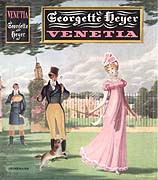I’ve always read history books. When I was little, one of our babysitters was a curator at the local museum in Leicester. My mother would take us there, and the curator, who was a family friend, would look after us while she did a bit of shopping. I grew up playing with old Victorian toys, and learning to be careful with them.
Was that the reason?
I read a lot. As a
child I was ill a lot. I caught everything, so I spent a lot of time in bed or
at home, in quarantine from some illness or other. When I’d done the school
work sent to me, I read. Lots. From the Famous Five to Sherlock Holmes and The
Saint. I read Dickens before I knew it was supposed to be difficult. And somewhere,
I caught the bug for the past, and I started reading text books as well.
When I was thirteen I started
reading Georgette Heyer’s books. She was my introduction to historical romance.
I devoured these books. With their historical accuracy and the sweet romances,
the witty banter followed at a kiss right at the end, they were the best
introduction possible to the historical romance. I discovered others. Barbara Cartland
I read and discarded. Her heroines were too waif-like for me, too needy, and
after a few reads they all blended together into one. When I started reading
books I’d read before, but not recognising it until I was halfway through, I realised
I was done with that particular author.
 Over the years I ventured
forth. Katherine Winsor, Anya Seton, Nora Lofts, Sergeanne Golon, Juliette
Benzoni – I read them all. for a while I lost the urge to read romance,
although I continued to read history books and learn as much as I could. I went
to university and learned how to do proper, methodical research and I loved it,
loved squirreling out details about the periods I was most interested in.
Over the years I ventured
forth. Katherine Winsor, Anya Seton, Nora Lofts, Sergeanne Golon, Juliette
Benzoni – I read them all. for a while I lost the urge to read romance,
although I continued to read history books and learn as much as I could. I went
to university and learned how to do proper, methodical research and I loved it,
loved squirreling out details about the periods I was most interested in.
Then, in the late
eighties and early nineties, I discovered the American historical romance. I read
Laura Kinsale and marvelled, then I read Catherine Coulter and marvelled for an
entirely different reason. Some of the books I read had barely any connection
with what I understood as real history. I couldn’t recognise the world I’d
grown to love in the plethora of inaccuracies and “okay”s. I started making
lists. Books I loved, books that didn’t suit me, and I found my comfortable
spot. George Macdonald Fraser’s Flashman could never be described as a romance,
but I eagerly awaited the release of every book. For wit and detail he’s rarely
surpassed.

And Dorothy Dunnett. How to classify Dunnett? The answer is that you can’t. It’s impossible. Dunnett stands in a class of her own, with rich, heartbreaking romances, a plethora of characters that would do Dickens proud, and research so deep it takes my breath away every time I read it. Dunnett delved into the little-known places, instead of accepting the norms. She invented characters that shouldn’t work, that had their life and being in the mores of the time, but also speak to us. True, the first book takes a bit of effort, but after that, you’re flying.
I want a historical novel that reflects a true picture of its time. Where people move in the spaces allotted to them by history. To be honest, I don’t care if they have fleas and don’t bathe, something naysayers often produce as an excuse not to put proper history in their books. I want that love story, rich and fulfilling, reflecting the characters in the books. I want to be taken to another time, another place, but part of the thrill for me is knowing that the times, if not the characters, existed, that if a time machine existed, I would recognise the time from the books. Stepping into those pages with someone I can respect and enjoy.
Now I try to write them, and that's proved as addictive as reading them.
That’s not much to
ask, is it?

Lynne's latest book is Danger Wears White. You can find it from all Amazons including UK US

Lynne Connolly
Lynne's latest book is Danger Wears White. You can find it from all Amazons including UK US

No comments:
Post a Comment